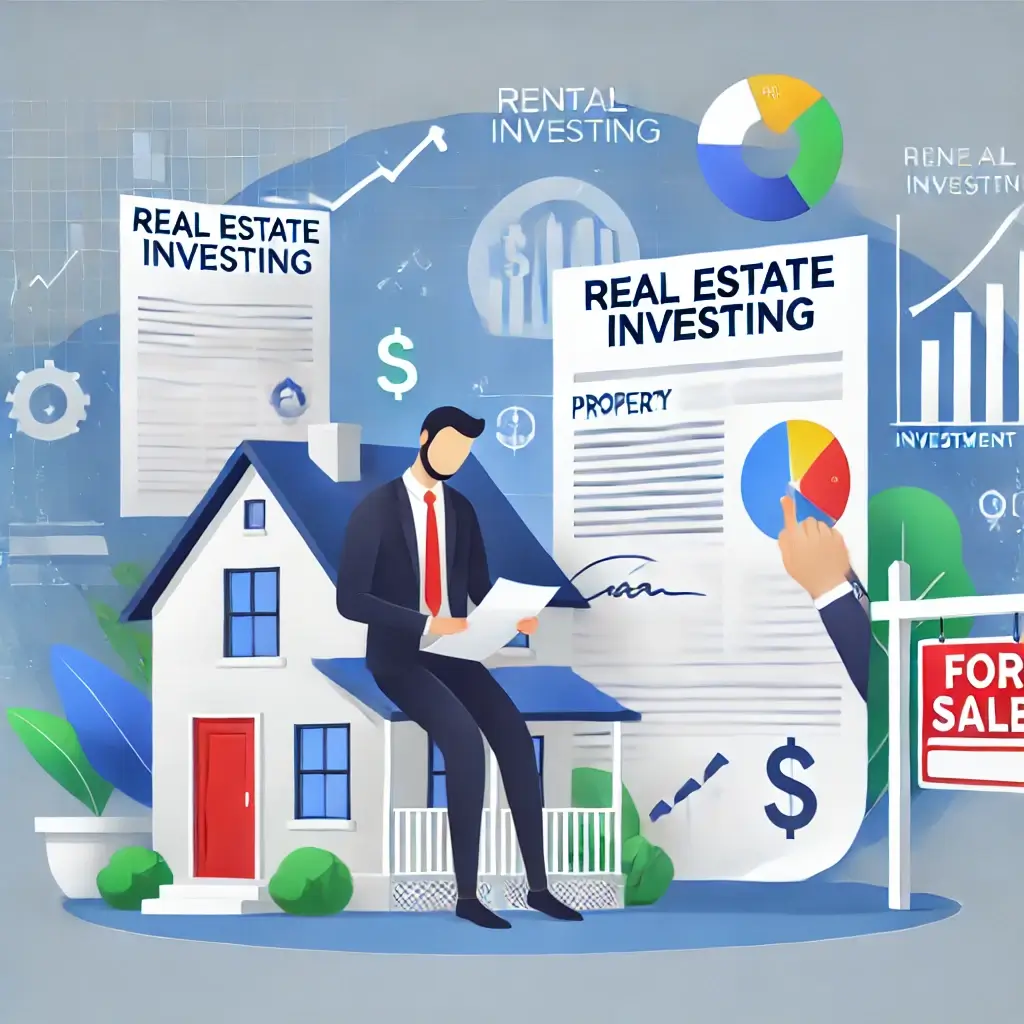Unlike volatile stocks or low-yield savings accounts, real estate investing offers a proven path to generational wealth. Here’s why it’s a powerhouse for building financial freedom:
- Crush Inflation: While cash loses value, real estate historically appreciates and generates rising rental income.
- Passive Income: Imagine earning $1,000/month from a rental property while you sleep.
- Diversification: Tangible assets protect your portfolio when markets crash (like 2008 or 2020).
“Real estate builds 90% of the world’s millionaires—but here’s the best part: you don’t need millions to start.”
Whether you’re a beginner with $5,000 or a seasoned investor, this guide will simplify real estate investing—from choosing your first property to scaling a portfolio. Let’s turn bricks and mortar into financial freedom. This article develops the following points:
- Why Invest in Real Estate? The Ultimate Wealth-Building Machine
- Types of Real Estate Investment Options: Find Your Perfect Fit
- How to Start Investing in Real Estate: Your Actionable Roadmap
- Real Estate Investing Risks & How to Mitigate Them
- Advanced Real Estate Strategies: Scale Your Portfolio Like a Pro
- Conclusion: Your Real Estate Investing Journey Starts Now

Why Invest in Real Estate? The Ultimate Wealth-Building Machine
Real estate isn’t just about owning property—it’s about unlocking unique financial advantages that other investments can’t match. Here’s why savvy investors allocate 20-30% of their portfolios to real estate:
1. Cash Flow: Passive Income That Outperforms Banks
- Rental income (your monthly paycheck) minus expenses = positive cash flow.
- Compare ROI using APY calculations: A 300,000 property netting 300,000 property netting 1,500/month yields 6% annually—triple the average savings account.
- Example: A duplex covering its mortgage + putting $500/month in your pocket.
2. Appreciation: Grow Wealth While You Sleep
- Historically, U.S. real estate appreciates 3-5% annually (source: Federal Reserve).
- Leverage multiplies gains: A 20% down payment on a 5% appreciating asset = 25% return on your cash.
3. Tax Advantages: Keep More of Your Money
- Deduct mortgage interest, repairs, and property taxes.
- Depreciation: Write off a portion of the property’s value annually (even while it gains real value).
- 1031 Exchanges: Defer capital gains taxes by reinvesting profits into new properties.
4. Inflation Hedge: Rents and Values Rise with Prices
- Inflation = higher rents + higher property values.
- Fixed-rate mortgages mean your biggest expense (the loan) stays the same while your income grows.
Key Takeaway: Real estate combines immediate cash flow, long-term wealth growth, and tax perks—all while protecting against inflation’s erosion.
Types of Real Estate Investment Options: Find Your Perfect Fit
Real estate investing isn’t one-size-fits-all. Whether you want hands-on management or passive income, these real estate investment options cater to every strategy and risk tolerance:
1. Residential Properties (Beginner-Friendly)
- Single-Family Homes: Easy to finance, lower maintenance. Ideal for first-time landlords.
- Multifamily (2-4 units): Live in one unit, rent others (“house hacking”) to eliminate your housing costs.
- Barrier to Entry: Low (FHA loans require just 3.5% down).
2. Commercial Real Estate (Higher Income Potential)
- Office/Retail Spaces: Longer leases (5-10 years) but sensitive to economic downturns.
- Industrial Warehouses: Booming with e-commerce (think Amazon fulfillment centers).
- Key Perk: Triple net leases (tenants pay taxes, insurance, and maintenance).
3. REITs (Real Estate Investment Trusts) (Passive & Liquid)
- Invest in real estate without buying property—just like stocks.
- Earn dividends from apartments, malls, or cell towers.
- Best For: Beginners or those wanting diversification (learn more in our Stock Market Guide).
4. Vacation Rentals (High ROI, High Effort)
- Airbnb/VRBO: Charge premium rates but require hands-on management.
- Pro Tip: Target tourist hotspots with >70% occupancy rates.
5. Land Investments (Long-Term Play)
- Raw Land: Buy and hold (cheap but illiquid).
- Development: Rezone/flip for massive profits (high risk/reward).
Matching Strategy to Goals:
- Passive income? → REITs or multifamily.
- High growth? → Development land or vacation rentals.
- Balance? → Single-family homes + commercial.
How to Start Investing in Real Estate: Your Actionable Roadmap
Ready to turn knowledge into profits? Follow these proven steps to launch your real estate investing journey with confidence:
1. Secure Financing (Even With Limited Capital)
- FHA Loans: You can buy a 1-4 unit property with just 3.5% down (you can live in one unit and rent the rest).
- Hard Money Loans: Short-term financing for flips (higher rates, faster approval).
- Partnerships: Pool resources with others (you find deals, they fund them).
2. Research Locations Like a Pro
Crush your competition by targeting neighborhoods with:
✅ Top school districts (families pay premium rents)
✅ Job growth (check local employers like Amazon/Tesla openings)
✅ Low crime rates (use NeighborhoodScout)
✅ Upcoming infrastructure (new highways = future appreciation)
3. Analyze Deals Like a Seasoned Investor
Master these 3 metrics (bonus: use our APR/APY Guide for ROI comparisons):
| Metric | Formula | What It Tells You | Good Range |
|---|---|---|---|
| Cap Rate | (Annual Rent – Expenses) / Purchase Price | ROI if paying cash | 6-10%+ |
| Cash-on-Cash | Annual Pre-Tax Cash Flow / Total Cash Invested | Your actual yield | 8-12%+ |
| NOI | Gross Income – Operating Expenses | True profitability before financing | Positive = 👍 |
Pro Tip: Start with one simple metric (e.g., “Does rent cover mortgage + 25% buffer?”).
Real Estate Investing Risks & How to Mitigate Them
Real estate offers incredible wealth-building potential, but only savvy investors succeed long-term by managing these key risks:
1. Market Cycle Risk (Don’t Buy at the Peak!)
- Problem: Overpaying during bubbles (e.g., the 2008 crash wiped out 30% of values).
- Solution:
- Buy in growing markets (population/jobs increasing).
- Focus on cash flow, not speculation (“If rents cover costs, you’ll survive downturns”).
2. Bad Tenant Risk (Nightmare Renters Cost Thousands!)
- Problem: Late payments, property damage, or evictions (avg. cost: $3,500).
- Solution:
- Credit checks: Minimum 650+ score. See our Credit Score Guide: How to Improve and Maintain Your Score for more details.
- Income verification: 3x rent in monthly earnings.
- References: Call past landlords (ask: “Would you rent to them again?”).
3. Maintenance Cost Risk (The Hidden Budget Killer!)
- Problem: A single roof replacement can cost $10,000+.
- Solution:
- Save 1-2% of property value annually (3,000/year for a 3,000 a/300k home).
- Pre-inspection: Uncover issues before buying (sewer lines, HVAC age).
- Handyman network: Build relationships for discounted repairs.
Bonus Risks & Quick Fixes:
- Liquidity Risk: Can’t sell fast? Stick to high-demand areas.
- Interest Rate Risk: Lock in fixed-rate mortgages.
- Vacancy Risk: Price competitively + offer lease renewals.
Key Takeaway: Real estate isn’t “passive” if you’re unprepared. Mitigate risks upfront to protect your profits.
Advanced Real Estate Strategies: Scale Your Portfolio Like a Pro
Ready to move beyond single-family homes? These high-impact strategies help experienced investors build wealth faster:
1. The BRRRR Method (Repeatable Wealth Machine)
Buy → Rehab → Rent → Refinance → Repeat
- How It Works:
- Buy a distressed property below market value.
- Renovate to boost value (e.g., 50krehab→50krehab→100k equity gain).
- Rent it out for cash flow.
- Refinance to pull out your original investment (now the property pays for itself).
- Repeat with the recycled capital!
- Best For: Investors with $50k+ to start (or partners).
2. House Hacking (Live for Free While Building Equity)
- Strategy: Buy a 2-4 unit property, live in one unit, rent the rest.
- Example: A 400 k duplex with 2,500 total rent:
- Your unit costs $0/month (tenant covers the mortgage).
- Bonus: FHA loans allow 3.5% down on multi-units.
3. Syndications (Invest in Big Deals Without the Headache)
- How It Works: Pool money with other investors to buy apartment complexes, hotels, or storage facilities ($ 1 M+ projects).
- You contribute capital → Pros handle management → Split profits.
- Minimums: Typically 50k−50k−100k per investor.
- Perks: Passive income + access to institutional-grade properties.
Scalability Comparison:
| Strategy | Startup Cost | Effort Level | Potential Scale |
|---|---|---|---|
| BRRRR | $50k+ | High | 10+ properties/yr |
| House Hacking | 3.5% down | Medium | 1-4 properties |
| Syndications | $50k+ | Passive | $1M+ deals |
Pro Tip: Start with house hacking, then graduate to BRRRR or syndications as you gain experience.
Conclusion: Your Real Estate Investing Journey Starts Now
Real estate investing is one of the most powerful wealth-building tools available—delivering cash flow, long-term appreciation, and unique tax advantages that stocks and bonds can’t match. Whether you’re looking for passive income, portfolio diversification, or financial freedom, property investing offers a path to get there.
The best part? You don’t need to start big.
- New investors: Begin with a REIT (no property management required) or a single-family rental (low-risk entry point).
- Ambitious builders: Scale faster with house hacking or the BRRRR method.
- Passive investors: Join a syndication and let experts handle the heavy lifting.
Your Next Step?
➤ If you’re hands-on: Find one deal this month—analyze it using the cap rate and cash-on-cash return formulas.
➤ If you prefer passive income: Research top-performing REITs today.
➤ Need guidance? Consult a real estate agent or financial advisor to tailor a strategy to your goals.
The market won’t wait—your first (or next) investment is out there. Will you claim it?

